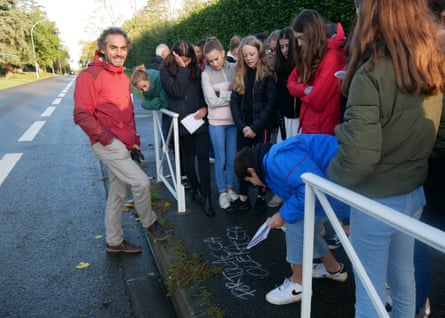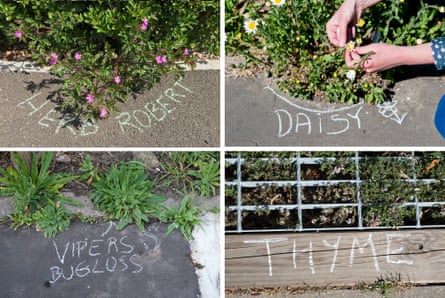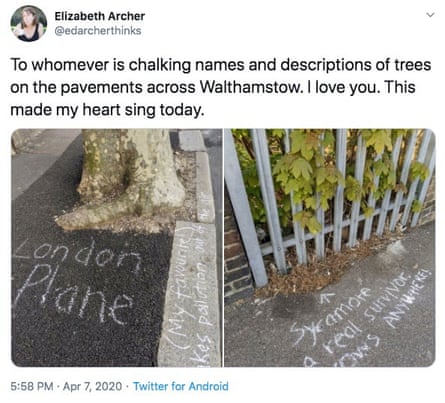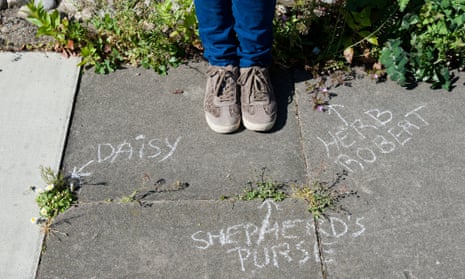A rising international force of rebel botanists armed with chalk has taken up street graffiti to highlight the names and importance of the diverse but downtrodden flora growing in the cracks of paths and walls in towns and cities across Europe.
The idea of naming wild plants wherever they go – which began in France – has gone viral, with people chalking and sharing their images on social media. More than 127,000 people have liked a photo of chalked-up tree names in a London suburb, while a video of botanist Boris Presseq of Toulouse Museum of Natural History chalking up names to highlight street flowers in the French city has had 7m views.

Presseq told the Guardian: “I wanted to raise awareness of the presence, knowledge and respect of these wild plants on sidewalks. People who had never taken the time to observe these plants now tell me their view has changed. Schools have contacted me since to work with students on nature in the city.”
France banned pesticide use in parks, streets and other public spaces in 2017 and in gardens from 2019, leading to a surge in awareness of urban wild flowers in the country.
French botanist and campaigner Sophie Leguil, who lives in London, set up the More Than Weeds campaign to change perceptions of urban plants in the UK after helping to spread the Sauvages de ma rue (“wild things of my street”) chalking campaign in France led by Tela Botanica. She has won permission to chalk up Hackney’s highways and make chalk trails to highlight the forgotten flora at our feet and is asking other councils to allow the same.
Q&AWhat is wild cities week?
Show
This week, the Guardian's Age of Extinction site is looking at biodiversity in cities and urban areas around the world, shining a spotlight on the under-appreciated world of nature hidden among the highrises and busy roads.
Around 55% of the world’s population live in urban areas and that number is projected to rise to 68% by 2050. Nature’s role in the wellbeing and happiness of billions of people will be more important than ever. While urbanisation is a major driver of biodiversity loss, many conservationists and town planners are trying to make built-up areas more nature-friendly. The role of green spaces in urban areas has even been formalised in a draft UN agreement to halt and reverse biodiversity loss, often referred to as the Paris agreement for nature.
The Covid-19 outbreak has seen cities and towns across the world go into lockdown which has enabled wildlife such as wild boar, deer, monkeys, foxes and even lions to venture into territory previously dominated by humans. It has also offered us the chance to notice and appreciate the natural world in cities in an unprecedented way.
In this special series of reports we'll be looking at how animals and plants adapt to city life, what to look out for right now and how we can encourage more wild cities in the future.
“The pesticide ban in France has played a major role as it has forced local authorities and mentalities to change, and raised awareness,” said Leguil.
“I’ve been wanting to do it on a larger scale, with permission, and I hope to get more authorities interested in creating trails. We talk a lot about plant blindness – what if putting names on plants could make people look at them in a different way? I despair at how sanitised London has become. Plants can be managed differently, with benefits – cost-saving, biodiversity, education.”

In the UK it is illegal to chalk anything – hopscotch, art or botanical names – on paths or highways without permission, even if it educates, celebrates and fosters interest and knowledge in nature.
One anonymous London tree name chalker said: “I’ll keep labelling as I go on my daily walks. I think it’s really tapped into where people are right now.
“Botanical chalking gives a quick blast of nature connection, as the words encourage you to look up and notice the tree above you, the leaves, the bark, the insects, the sky. And that’s all good for mental health. None of us can manage that much – living through a global pandemic is quite enough to be getting on with. But it’s brought me a great amount of joy.”

UK Plantlife spokesman Trevor Dines said the charity could not condone breaking the law, but added: “The incredible response to graffiti plant names is astonishing and I think it’s part of something profound. It’s as if the plant is declaring its own place in our world.
“In a recent YouGov poll, just 6% of 16- to 24-year-olds were able to correctly name a picture of a wild violet. The same poll showed nearly 70% of respondents would like to be able to identify more wild flowers.”

With less spraying and weeding, we might expect to see up to 400 plant species on walls and paths, he suggests. That is 10% of our wild flora richness.
“One survey of pavements in Sheffield found 183 different plants, another in Cambridge found 186 species on walls. All these little micro niches build up to a wonderfully complex tapestry,” Dines said.
“Every flower counts and will be targeted by pollinators – a patch of nettles can be swamped with caterpillars. And bird’s-foot-trefoil, a not uncommon urban verge plant, is a food plant for more than 160 different invertebrates. If we change our perceptions and see the dandelion flower for what it is – an absolute lifeline to our bees in early spring – we might learn to love them more.”
A study by pollinator researchers revealed that many wild urban “weeds” rank very highly for the quantity of nectar and pollen each flower provides, often much higher than a variety of garden plants. The top trumps among the plants they measured included dandelions and their lookalikes – rough hawkbit, cat’s-ear and sow-thistles – plus ragwort, viper’s bugloss, mallows, self-heal, scentless mayweed, love-in-a-mist, wild mignonette, rosebay willowherb, thistles, creeping buttercup and poppies.

Andrew Whitehouse, of conservation trust Buglife, said path and wall plants are also important as winter food sources when there is less blossom available for insects such as bumblebees. “Below the concrete, the roots create tiny microhabitats that support woodlice, worms, harvestmen, spiders, baby slugs and snails, which in turn become the food for birds and hedgehogs,” he added.
Cllr Jon Burke, of Hackney Council, which has gone pesticide-free in some areas and halved its use overall to increase wild flowers and boost insect biodiversity following public concern, said: “It is absurd that this chalking of plant names is criminal. It is something we welcome as an important and inspiring teaching tool for adults and children. How else will a kid ever know these names? The vocabulary of the natural world helps us access it, love it and desire to protect it.”
Criminal law expert James Gray of Drystone Chambers confirmed that chalking plant names in the UK is illegal without permission or “lawful excuse” and a rebel botanist could be fined up to £2,500 for painting or inscribing any picture, letter, sign, or other mark on a path, highway surface, tree or other structure.

Referring to Victor Hugo’s famous fictional police inspector, Gray added: “The Javerts of this world will see great harm in the scribbles of rogue botanists and call for prosecutions, others will see it as entirely harmless and perhaps even a refreshing diversion in our streets.”
He added: “Where the threshold lies will depend on the attitude of those charged with enforcing the law; beauty (or derangement) is in the eye of the magistrate.”
Find more age of extinction coverage here, and follow biodiversity reporters Phoebe Weston and Patrick Greenfield on Twitter for all the latest news and features

Comments (…)
Sign in or create your Guardian account to join the discussion